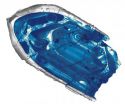(Press-News.org) PISCATAWAY, NJ – Although some advocates want to lower the legal drinking age from 21, research continues to show that the law saves lives. That's the finding of a new review published in a special supplemental issue to the Journal of Studies on Alcohol and Drugs.
Researchers found that studies done since 2006—when a new debate over age-21 laws flared up—have continued to demonstrate that the mandates work. The laws, studies show, are associated with lower rates of drunk-driving crashes among young people. And it seems they also curb other hazards of heavy drinking—including suicide, dating violence and unprotected sex.
"The evidence is clear that there would be consequences if we lowered the legal drinking age," said lead researcher William DeJong, Ph.D., of Boston University School of Public Health.
The U.S. legal-drinking age has had a winding history. In the early 1970s, 29 states lowered their legal drinking age to 18, 19 or 20. But after a rise in drunk-driving crashes among young people, many states began to reverse course. A change in federal law eventually pushed all states to adopt a minimum drinking age of 21 by 1988.
But in recent years, the benefits of the age-21 law have been challenged.
In 2006, a non-profit called Choose Responsibility started campaigning for a change in the federal law. Two years later, a group of more than 100 U.S. university presidents and chancellors known as the Amethyst Initiative called for a re-evaluation of the legal drinking age—citing a "clandestine" culture of heavy drinking episodes among college students as one reason that the age-21 law is not working.
Those moves grabbed a lot of media attention, and public health experts responded by launching new studies into the impact of the drinking-age law.
Based on DeJong's review, that research supports what earlier work had shown: Since the legal drinking age was set at 21, young people have been drinking less and are less likely to get into drunk-driving crashes.
In one study, researchers found that, in 2011, 36 percent of college students said in the past two weeks they'd engaged in heavy episodic drinking (five or more drinks in a sitting, sometimes called "binge" drinking). That compared with 43 percent of students in 1988, the first year that all U.S. states had an age-21 law. There was an even bigger decline among high school seniors—from 35 percent to 22 percent.
Of course, many young people break the law and drink anyway. But, DeJong said, the evidence shows that the law is working despite that. That may be, in part, because minors do not want to be caught drinking, and therefore take fewer risks—like getting behind the wheel.
Plus, DeJong said, "there are many young people who do wait until they're 21 to drink."
DeJong said that education can help discourage underage drinking. Often, youths buy into the myth, for instance, that all college students engage in heavy drinking episodes. So giving them a more realistic picture of the true "drinking norms" can be effective, DeJong explained.
And, he said, tougher enforcement of the age-21 law, rather than a repeal, is what's needed. "Just because a law is commonly disobeyed doesn't mean we should eliminate it," DeJong noted. Clinical trials have found that when college towns put more effort into enforcing the law—and advertise that fact to students—student drinking declines.
"Some people assume that students are so hell-bent on drinking, nothing can stop them," DeJong said. "But it really is the case that enforcement works."
INFORMATION:
DeJong, W., & Blanchette, J. (March 2014). Case closed: Research evidence on the positive public health impact of the age 21 minimum legal drinking age in the United States. Journal of Studies on Alcohol and Drugs, Supplement No. 17, 108-115.
To arrange an interview with William DeJong, Ph.D., please contact Kara Peterson at (617) 638-4052 or kara@bu.edu.
The Journal of Studies on Alcohol and Drugs is published by the Center of Alcohol Studies at Rutgers, The State University of New Jersey. It is the oldest substance-related journal published in the United States. DeJong & Blanchette's article is publishing within a special supplemental issue of the Journal of Studies on Alcohol and Drugs (Supplement No. 17, also called Alcohol Studies: 75 Years in Review). This issue celebrates the 75th anniversary of the Journal of Studies on Alcohol and Drugs by providing a series of reviews of the alcohol-science literature from 1940 to the present. The issue is available online to JSAD subscribers and on a pay-per-view basis to nonsubscribers. Print copies of the supplement will be available through the journal's website and through Amazon.com.
To learn about education and training opportunities for addiction counselors and others at the Rutgers Center of Alcohol Studies, please visit AlcoholStudiesEd.rutgers.edu.
Age-21 drinking laws save lives, study confirms
2014-02-24
ELSE PRESS RELEASES FROM THIS DATE:
Secondary thyroid cancer more deadly than primary malignancy in young individuals
2014-02-24
A new analysis has found that adolescents and young adults who develop thyroid cancer as a secondary cancer have a significantly greater risk of dying than those with primary thyroid cancer. Published early online in Cancer, a peer-reviewed journal of the American Cancer Society, the findings stress the importance of screening young cancer survivors to detect early signs of a potentially life-threatening thyroid malignancy.
Thyroid cancer is one of the five most common malignancies in adolescent and young adult patients (ages 15 to 39 years). It can develop as an initial ...
Computerized checklist reduces type of hospital infection, Stanford/Packard study finds
2014-02-24
STANFORD, Calif. - A computerized safety checklist that automatically pulls information from patients' electronic medical records was associated with a threefold drop in rates of one serious type of hospital-acquired infection, according to a study by researchers at the Stanford University School of Medicine and Lucile Packard Children's Hospital Stanford.
The study, conducted in the hospital's pediatric intensive care unit, targeted bloodstream infections that begin in central lines - catheters inserted into major veins. The infections are a preventable cause of illness ...
Children's Mercy physician leads effort to update AAP policy
2014-02-24
KANSAS CITY, MO – February 24, 2014 – With less than half of medications including specific labeling for children, Kathleen Neville, MD, MS, a physician at Children's Mercy Hospital, recently led an American Academy of Pediatrics (AAP) committee in updating the policy with new recommendations guiding the off-label use of drugs in pediatric patients. The policy statement, "Off-Label Use of Drugs in Children," was published online today in the March 2014 issue of Pediatrics.
Dr. Neville is chair of the AAP Committee on Drugs and Director of Experimental Therapeutics in ...
New study settles how social understanding is performed by the brain
2014-02-24
In a study to be published in Psychological Science, researchers from Aarhus University and the University of Copenhagen demonstrate that brain cells in what is called the mirror system help people make sense of the actions they see other people perform in everyday life.
Using magnetic stimulation to temporarily disrupt normal processing of the areas of the human brain involved in the production of actions of human participants, it is demonstrated that these areas are also involved in the understanding of actions. The study is the first to demonstrate a clear causal ...
New process uses recyclable catalyst to create porous materials
2014-02-24
A team of UConn chemists has discovered a new way of making a class of porous materials that allows for greater manufacturing controls and has significantly broader applications than the longtime industry standard.
The process, more than three years in the making, has resulted in the creation of more than 60 new families of materials so far, with the potential for many more. The key catalyst in the process is recyclable, making it a 'green' technology.
"This is definitely the most exciting project I've been involved in over the past 30 years," says Board of Trustees ...
New insights into the origin of birds
2014-02-24
Mark Puttick and colleagues investigated the rates of evolution of the two key characteristics that preceded flight: body size and forelimb length. In order to fly, hulking meat-eating dinosaurs had to shrink in size and grow much longer arms to support their feathered wings.
"We were really surprised to discover that the key size shifts happened at the same time, at the origin of Paraves," said Mr Puttick of Bristol's School of Earth Sciences. "This was at least 20 million years before the first bird, the famous Archaeopteryx, and it shows that flight in birds arose ...
Policies to green the economy must underpin UK recovery: New report
2014-02-24
The UK urgently needs a green economic strategy to move towards low-carbon prosperity, resource security and environmental quality, says a new report published today by UCL's Green Economy Policy Commission.
The Commission – drawn from a range of academic disciplines across UCL – argues that the UK's current situation of climate instability and increasing resource constraints mean that decisive action is urgently needed by the UK government to green the economy.
Greening the Recovery argues that there is a window of opportunity for policies that acknowledge future ...
Mysterious polio-like illness found in 5 California children
2014-02-23
PHILADELPHIA – Researchers have identified a polio-like syndrome in a cluster of children from California over a one-year period, according to a case report released today that will be presented at the American Academy of Neurology's 66th Annual Meeting in Philadelphia, April 26 to May 3, 2014.
"Although poliovirus has been eradicated from most of the globe, other viruses can also injure the spine, leading to a polio-like syndrome," said case report author Keith Van Haren, MD, with Stanford University in Palo Alto, Calif., and a member of the American Academy of Neurology. ...
Scientists transform skin cells into functioning liver cells
2014-02-23
SAN FRANCISCO, CA—February 23, 2014—The power of regenerative medicine now allows scientists to transform skin cells into cells that closely resemble heart cells, pancreas cells and even neurons. However, a method to generate cells that are fully mature—a crucial prerequisite for life-saving therapies—has proven far more difficult. But now, scientists at the Gladstone Institutes and the University of California, San Francisco (UCSF), have made an important breakthrough: they have discovered a way to transform skin cells into mature, fully functioning liver cells that flourish ...
Oldest bit of crust firms up idea of a cool early Earth
2014-02-23
MADISON, Wis. – With the help of a tiny fragment of zircon extracted from a remote rock outcrop in Australia, the picture of how our planet became habitable to life about 4.4 billion years ago is coming into sharper focus.
Writing today (Feb. 23, 2014) in the journal Nature Geoscience, an international team of researchers led by University of Wisconsin-Madison geoscience Professor John Valley reveals data that confirm the Earth's crust first formed at least 4.4 billion years ago, just 160 million years after the formation of our solar system. The work shows, Valley says, ...

